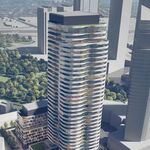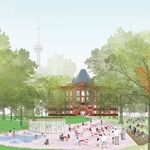Sorry to go off topic on this nuclear power plant thread, but development of the commercial buildings on Danforth from Broadview east was rather disjointed with many vacant lots that up until the early 1970s were occupied by new and used-car dealer lots. In Eric Arthur's "No Mean City" there is a section near the end of the book where the Toronto of the day (mid-1960s) is assessed, and I think it was Arthur who refers to the "cult of ugliness" on Danforth Avenue, with its preponderance of used-car lots and gaudy lights to illuminate the lots at night. Just from memory: Carrot Common was once home to a car dealership (Hogan?), there was a car lot and gas station at the bottom of Donlands (one of the Joy stations), Robertson Motors was west of Coxwell, there were more large ones between Woodbine and Main (City Pontiac-Buick and a Ford dealership), and several small used-car lots were scattered all the way along in between. Some remnants of these remain as the auto garage between Lamb and Gillard, the vacant lots on the south side west of Main St. and of course there are still a couple of dealerships in business in the area - Honda and Hyundai.
Where Bloor St. West had a more solid line of commercial buildings, Danforth had a far more porous commercial strip.
Also, the gap created by subway construction for the wye connection to the Greenwood Yard took out a number of buildings on the north side west of Greenwood, now occupied by the Greenwood Towers highrise. At Coxwell, there was the streetcar yard/bus garage on the south-east corner and at Main St. there was a large lumber/coal yard on the south-east corner before it all went up in flames in 1967 or 1968.
Bloor West has Christie Pits, the only park fronting on Danforth is West Lynn Park near Woodbine, much smaller than Christie Pits. Bloor West had an industrial zone between Lansdowne and Dundas near the rail lines (Canada Bread was a major occupant at Bloor & Dundas) but that was about it.
The only other thing I can think of is that the old city limits were only three blocks or so north of Danforth from Broadview to Woodbine, while in the west, the city limits were much further north (north of St. Clair) so development within the city limits would have been much more dense on the west side.
TL

R version - Bloor was a more solid commercial street serving a denser area that was built up much earlier than Danforth, which had a lot of car lots and other non-retail uses resulting in a much less vibrant commercial strip.




